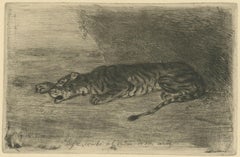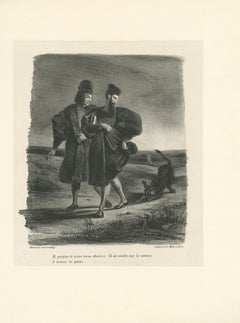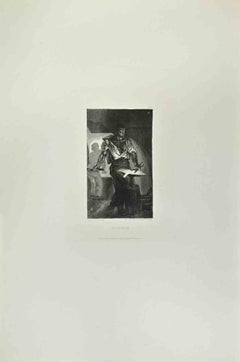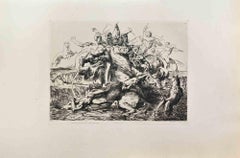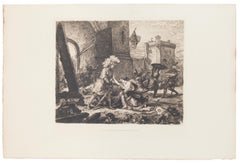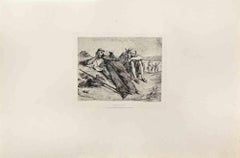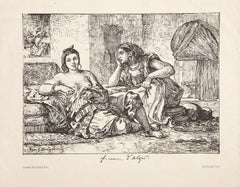Eugene Delacroix Art
French, 1798-1863
Ferdinand Victor Eugène Delacroix (French: 26 April 1798 – 13 August 1863) was a French Romantic artist regarded from the outset of his career as the leader of the French Romantic school.
In contrast to the Neoclassical perfectionism of his chief rival Ingres, Delacroix took for his inspiration the art of Rubens and painters of the Venetian Renaissance, with an attendant emphasis on colour and movement rather than clarity of outline and carefully modelled form. Dramatic and romantic content characterized the central themes of his maturity, and led him not to the classical models of Greek and Roman art, but to travel in North Africa, in search of the exotic. Friend and spiritual heir to Théodore Géricault, Delacroix was also inspired by Lord Byron, with whom he shared a strong identification with the "forces of the sublime", of nature in often violent action.
However, Delacroix was given to neither sentimentality nor bombast, and his Romanticism was that of an individualist. In the words of Baudelaire, "Delacroix was passionately in love with passion, but coldly determined to express passion as clearly as possible."Together with Ingres, Delacroix is considered one of the last old Masters of painting and is one of the few who was ever photographed.
As a painter and muralist, Delacroix's use of expressive brushstrokes and his study of the optical effects of colour profoundly shaped the work of the Impressionists, while his passion for the exotic inspired the artists of the Symbolist movement. A fine lithographer, Delacroix illustrated various works of William Shakespeare, the Scottish author Walter Scott, and the German author Johann Wolfgang von Goethe.to
4
3
6
3
2
2
2
1
1
1
1
1
1
Tigre couché à l'entrée de son antre (Tiger Lying at the Entrance to its Lair)
By Eugène Delacroix
Located in Middletown, NY
Etching, drypoint, and roulette on watermarked Hallines cream laid paper, 3 3/4 x 5 7/8 inches (95 x 148 mm), full margins. A very good impression of this charming image, with all of...
Category
Early 19th Century Realist Eugene Delacroix Art
Materials
Laid Paper, Drypoint, Etching
Faust, Méphistophélès et le Barbet / Faust, Méphistophélès and the Water Spaniel
By Eugène Delacroix
Located in Middletown, NY
Lithograph on Chine appliqué, 9 1/4 x 8 1/8 inches (235 x 206 mm), full margins. First state (of 4). Extremely minor uniform age tone, otherwise in good condition. A superb, richly-inked impression.
[Delteil 61.1]
______
At an early age Delacroix became a lover of music and literature and had been drawing from the time he entered school. He expected painting would be a hobby, but on the death of his father he found he had to make his own way in life. In 1817 he entered the studio of Pierre-Narcisse Guerin; amongst his fellow pupils was Gericault. His first exhibited work was Dante and Virgil...
Category
Early 19th Century Barbizon School Eugene Delacroix Art
Materials
Lithograph, Handmade Paper
The Italian Poet Tasso in the Madhouse - Etching
By Eugène Delacroix
Located in Paris, IDF
Eugène DELACROIX (1798-1863)
Tasso in the Madhouse
Engraving after a drawing
Signed on the plate
On vellum 38 x 50 cm
INFORMATION: In 1839, Delacroix painted his famous painting "T...
Category
Early 20th Century Modern Eugene Delacroix Art
Materials
Etching
Un Forgeron - Etching by Eugène Delacroix - 1870s
By Eugène Delacroix
Located in Roma, IT
Un Forgeron is an artwork realized by Eugène Delacroix in the 1870s.
Etching.
Good conditions.
Realized for the "Société des Aquafortistes. Born on the initiative of the publisher...
Category
1870s Modern Eugene Delacroix Art
Materials
Etching
Surprise - Etching by François Chifflart - 1860s
By Eugène Delacroix
Located in Roma, IT
Surprise is a black and White etching realized by François Chifflart in the 1860s.
Titled in the lower.
Image size: 24x32.
Very good impression with wide margins and a very fresh...
Category
1860s Modern Eugene Delacroix Art
Materials
Etching
La Delivrance De La Princesse Olga - Etching by M.Roux after E. Delacroix - 1911
By Eugène Delacroix
Located in Roma, IT
Image dimensions: 24 x 28 cm.
La Delivrance De La Princesse Olga is an original print in etching technique on ivory-colored paper, realized by M. Roux after Eugène Delacroix .
In v...
Category
1910s Romantic Eugene Delacroix Art
Materials
Lithograph
Muletiers de Tetuan, Modern Lithograph by Eugene Delacroix
By Eugène Delacroix
Located in Long Island City, NY
Eugene Delacroix, French (1798 - 1863) - Muletiers de Tetuan, Year: 1833, Medium: Lithograph on Japon, Image Size: 8 x 10.5 inches, Size: 9.5 x 14 in. (24.13 x 35.56 cm), Publisher...
Category
1830s Old Masters Eugene Delacroix Art
Materials
Lithograph
Lionne Dechirant la Poitrine d'un Arabe, Modern Etching by Eugene Delacroix
By Eugène Delacroix
Located in Long Island City, NY
Eugene Delacroix, French (1798 - 1863) - Lionne Dechirant la Poitrine d'un Arabe, Year: 1849, Medium: Soft Ground Etching, signed and dated in the plate, Image Size: 8 x 10.75 inch...
Category
1840s Old Masters Eugene Delacroix Art
Materials
Etching
Related Items
Meditation and Minou
By Will Barnet
Located in Buffalo, NY
Artist: Will Barnet, American (1911 - 2012)
Title: Meditation and Minou
Year: 1980
Medium: Lithograph and Serigraph on BFK Rives, signed and numbered in pencil
Edition: 40/150
Category
1970s American Realist Eugene Delacroix Art
Materials
Archival Paper, Lithograph
Woman with Birds
By Sunol Alvar
Located in San Francisco, CA
Artist: Alvar
Title: Woman with Birds
Year: c.1980
Medium: Color lithograph
Paper: Wove
Image size: 18.5 x 24.5 inches
Framed size: 26.5 x 32.65 inc...
Category
Late 20th Century Romantic Eugene Delacroix Art
Materials
Lithograph
Une Escale au Brasil (A Stopover in Brazil)
By Charles Dufresne
Located in New York, NY
Charles Dufresne (1876-1938), Une Escale au Brasil (A Stopover in Brazil), etching and drypoint, c. 1920, signed in pencil lower right margin and inscribed “epreuve de artist” lower ...
Category
1920s Modern Eugene Delacroix Art
Materials
Drypoint, Etching
19th century color lithograph figures cemetery willow tree memorial headstone
By Nathaniel Currier
Located in Milwaukee, WI
The present hand-colored lithograph was produced as part of the funeral and mourning culture in the United States during the 19th century. Images like this were popular as ways of remembering loved ones, an alternative to portraiture of the deceased. This lithograph shows a man, woman and child in morning clothes next to an urn-topped stone monument. Behind are additional putto-topped headstones beneath weeping willows, with a steepled church beyond. The monument contains a space where a family could inscribe the name and death dates of a deceased loved one. In this case, it has been inscribed to a young Civil War soldier:
William W. Peabody
Died at Fairfax Seminary, VA
December 18th, 1864
Aged 18 years
The young Mr. Peabody probably died in service for the Union during the American Civil War. Farifax Seminary was a Union hospital and military headquarters in Alexandria, Virginia. The hospital served nearly two thousand soldiers during the war time. Five hundred were also buried on the Seminary's grounds.
13.75 x 9.5 inches, artwork
23 x 19 inches, frame
Published before 1864
Inscribed bottom center "Lith. & Pub. by N. Currier. 2 Spruce St. N.Y."
Framed to conservation standards using 100 percent rag matting and TruVue Conservation Clear glass, housed in a gold gilded moulding.
Nathaniel Currier was a tall introspective man with a melancholy nature. He could captivate people with his piercing stare or charm them with his sparkling blue eyes. Nathaniel was born in Roxbury, Massachusetts on March 27th, 1813, the second of four children. His parents, Nathaniel and Hannah Currier, were distant cousins who lived a humble yet spartan life. When Nathaniel was eight years old, tragedy struck. Nathaniel’s father unexpectedly passed away leaving Nathaniel and his eleven-year-old brother Lorenzo to provide for the family. In addition to their mother, Nathaniel and Lorenzo had to care for six-year-old sister Elizabeth and two-year-old brother Charles. Nathaniel worked a series of odd jobs to support the family, and at fifteen, he started what would become a life-long career when he apprenticed in the Boston lithography shop of William and John Pendleton.
A Bavarian gentleman named Alois Senefelder invented lithography just 30 years prior to young Nat Currier’s apprenticeship. While under the employ of the brothers Pendleton, Nat was taught the art of lithography by the firm’s chief printer, a French national named Dubois, who brought the lithography trade to America.
Lithography involves grinding a piece of limestone flat and smooth then drawing in mirror image on the stone with a special grease pencil. After the image is completed, the stone is etched with a solution of aqua fortis leaving the greased areas in slight relief. Water is then used to wet the stone and greased-ink is rolled onto the raised areas. Since grease and water do not mix, the greased-ink is repelled by the moisture on the stone and clings to the original grease pencil lines. The stone is then placed in a press and used as a printing block to impart black on white images to paper.
In 1833, now twenty-years old and an accomplished lithographer, Nat Currier left Boston and moved to Philadelphia to do contract work for M.E.D. Brown, a noted engraver and printer. With the promise of good money, Currier hired on to help Brown prepare lithographic stones of scientific images for the American Journal of Sciences and Arts. When Nat completed the contract work in 1834, he traveled to New York City to work once again for his mentor John Pendleton, who was now operating his own shop located at 137 Broadway. Soon after the reunion, Pendleton expressed an interest in returning to Boston and offered to sell his print shop to Currier. Young Nat did not have the financial resources to buy the shop, but being the resourceful type he found another local printer by the name of Stodart. Together they bought Pendleton’s business.
The firm ‘Currier & Stodart’ specialized in "job" printing. They produced many different types of printed items, most notably music manuscripts for local publishers. By 1835, Stodart was frustrated that the business was not making enough money and he ended the partnership, taking his investment with him. With little more than some lithographic stones, and a talent for his trade, twenty-two year old Nat Currier set up shop in a temporary office at 1 Wall Street in New York City. He named his new enterprise ‘N. Currier, Lithographer’
Nathaniel continued as a job printer and duplicated everything from music sheets to architectural plans. He experimented with portraits, disaster scenes and memorial prints, and any thing that he could sell to the public from tables in front of his shop. During 1835 he produced a disaster print Ruins of the Planter's Hotel, New Orleans, which fell at two O’clock on the Morning of the 15th of May 1835, burying 50 persons, 40 of whom Escaped with their Lives. The public had a thirst for newsworthy events, and newspapers of the day did not include pictures. By producing this print, Nat gave the public a new way to “see” the news. The print sold reasonably well, an important fact that was not lost on Currier.
Nat met and married Eliza Farnsworth in 1840. He also produced a print that same year titled Awful Conflagration of the Steamboat Lexington in Long Island Sound on Monday Evening, January 18, 1840, by which melancholy occurrence over One Hundred Persons Perished. This print sold out very quickly, and Currier was approached by an enterprising publication who contracted him to print a single sheet addition of their paper, the New York Sun. This single page paper is presumed to be the first illustrated newspaper ever published.
The success of the Lexington print launched his career nationally and put him in a position to finally lift his family up. In 1841, Nat and Eliza had their first child, a son they named Edward West Currier. That same year Nat hired his twenty-one year old brother Charles and taught him the lithography trade, he also hired his artistically inclined brother Lorenzo to travel out west and make sketches of the new frontier as material for future prints. Charles worked for the firm on and off over the years, and invented a new type of lithographic crayon which he patented and named the Crayola. Lorenzo continued selling sketches to Nat for the next few years.
In 1843, Nat and Eliza had a daughter, Eliza West Currier, but tragedy struck in early 1847 when their young daughter died from a prolonged illness. Nat and Eliza were grief stricken, and Eliza, driven by despair, gave up on life and passed away just four months after her daughter’s death.
The subject of Nat Currier’s artwork changed following the death of his wife and daughter, and he produced many memorial prints and sentimental prints during the late 1840s. The memorial prints generally depicted grief stricken families posed by gravestones (the stones were left blank so the purchasers could fill in the names of the dearly departed). The sentimental prints usually depicted idealized portraits of women and children, titled with popular Christian names of the day.
Late in 1847, Nat Currier married Lura Ormsbee, a friend of the family. Lura was a self-sufficient woman, and she immediately set out to help Nat raise six-year-old Edward and get their house in order. In 1849, Lura delivered a son, Walter Black Currier, but fate dealt them a blow when young Walter died one year later. While Nat and Lura were grieving the loss of their new son, word came from San Francisco that Nat’s brother Lorenzo had also passed away from a brief illness. Nat sank deeper into his natural quiet melancholy. Friends stopped by to console the couple, and Lura began to set an extra place at their table for these unexpected guests. She continued this tradition throughout their lives.
In 1852, Charles introduced a friend, James Merritt Ives, to Nat and suggested he hire him as a bookkeeper. Jim Ives was a native New Yorker born in 1824 and raised on the grounds of Bellevue Hospital where his father was employed as superintendent. Jim was a self-trained artist and professional bookkeeper. He was also a plump and jovial man, presenting the exact opposite image of his new boss.
Jim Ives met Charles Currier through Caroline Clark, the object of Jim’s affection. Caroline’s sister Elizabeth was married to Charles, and Caroline was a close friend of the Currier family. Jim eventually proposed marriage to Caroline and solicited an introduction to Nat Currier, through Charles, in hopes of securing a more stable income to support his future wife.
Ives quickly set out to improve and modernize his new employer’s bookkeeping methods. He reorganized the firm’s sizable inventory, and used his artistic skills to streamline the firm’s production methods. By 1857, Nathaniel had become so dependent on Jims’ skills and initiative that he offered him a full partnership in the firm and appointed him general manager. The two men chose the name ‘Currier & Ives’ for the new partnership, and became close friends.
Currier & Ives produced their prints in a building at 33 Spruce Street where they occupied the third, fourth and fifth floors. The third floor was devoted to the hand operated printing presses that were built by Nat's cousin, Cyrus Currier, at his shop Cyrus Currier & Sons in Newark, NJ. The fourth floor found the artists, lithographers and the stone grinders at work. The fifth floor housed the coloring department, and was one of the earliest production lines in the country. The colorists were generally immigrant girls, mostly German, who came to America with some formal artistic training. Each colorist was responsible for adding a single color to a print. As a colorist finished applying their color, the print was passed down the line to the next colorist to add their color. The colorists worked from a master print displayed above their table, which showed where the proper colors were to be placed. At the end of the table was a touch up artist who checked the prints for quality, touching-in areas that may have been missed as it passed down the line. During the Civil War, demand for prints became so great that coloring stencils were developed to speed up production.
Although most Currier & Ives prints were colored in house, some were sent out to contract artists. The rate Currier & Ives paid these artists for coloring work was one dollar per one hundred small folios (a penny a print) and one dollar per one dozen large folios. Currier & Ives also offered uncolored prints to dealers, with instructions (included on the price list) on how to 'prepare the prints for coloring.' In addition, schools could order uncolored prints from the firm’s catalogue to use in their painting classes.
Nathaniel Currier and James Merritt Ives attracted a wide circle of friends during their years in business. Some of their more famous acquaintances included Horace Greeley, Phineas T. Barnum, and the outspoken abolitionists Rev. Henry Ward, and John Greenleaf Whittier (the latter being a cousin of Mr. Currier).
Nat Currier and Jim Ives described their business as "Publishers of Cheap and Popular Pictures" and produced many categories of prints. These included Disaster Scenes, Sentimental Images, Sports, Humor, Hunting Scenes, Politics, Religion, City and Rural Scenes, Trains, Ships, Fire Fighters, Famous Race Horses, Historical Portraits, and just about any other topic that satisfied the general public's taste. In all, the firm produced in excess of 7500 different titles, totaling over one million prints produced from 1835 to 1907.
Nat Currier retired in 1880, and signed over his share of the firm to his son Edward. Nat died eight years later at his summer home 'Lion’s Gate' in Amesbury, Massachusetts. Jim Ives remained active in the firm until his death in 1895, when his share of the firm passed to his eldest son, Chauncey.
In 1902, faced will failing health from the ravages of Tuberculosis, Edward Currier sold his share of the firm to Chauncey Ives...
Category
Mid-19th Century Romantic Eugene Delacroix Art
Materials
Watercolor, Lithograph
19th century color lithograph watercolor landscape figurative animal print
By Nathaniel Currier
Located in Milwaukee, WI
The present hand-colored lithograph presents the viewer with a hunting scene in a picturesque landscape. In the foreground, a man approaches two partridges as his two pointers prepare to flush them out. Beyond, a white fence draws our eyes to the homestead in the distance. Images like this one show how people in the United States were trying to identify themselves as a new nation in the North American landscape - as separate from their European counterparts but with similar similar and specific wildlife and magesties of nature. It also identifies hunting in this landscape as an American pastime.
9.25 x 12.5 inches, artwork
18.38 x 22 inches, frame
Entitled bottom center "Partridge Shooting...
Category
Mid-19th Century Romantic Eugene Delacroix Art
Materials
Watercolor, Lithograph
20th century drypoint etching figurative animal print horses sketch signed
By Claude Weisbuch
Located in Milwaukee, WI
"Combat Equestre" is an original lithograph by Claude Weisbuch. The artist signed the piece lower right and wrote the edition number (24/100) in the lower left. This piece depicts mu...
Category
1970s Modern Eugene Delacroix Art
Materials
Drypoint, Etching
$4,050
H 27.25 in W 31.25 in
"Que pico de Oro" (What a Golden Beak) - Etching and Aquatint on Paper
By Francisco Goya
Located in Soquel, CA
"Que pico de Oro" (What a Golden Beak) - Etching and Aquatint on Paper
5th or 8th edition print of "Que pico de Oro" from the Los Caprichos with burnished aquatints, drypoints etchi...
Category
1790s Northern Renaissance Eugene Delacroix Art
Materials
Engraving, Etching, Aquatint, Laid Paper
$3,850
H 20 in W 16 in D 0.5 in
Mid Century Chevaux et Cavalières La Nuit Lithograph
By Hoi Lebadang
Located in Soquel, CA
Mid Century Nocturnal Horses with Riders Under Moonlight Lithograph Limited Edition
Compelling nocturnal lithograph of two women on horseback by ...
Category
1960s Abstract Impressionist Eugene Delacroix Art
Materials
Paper, Lithograph
$1,100
H 25.25 in W 19.25 in D 1 in
La Mort du Chat Murr - Etching by Jean François Raffaëlli - 1875
By Jean-Francois Raffaelli
Located in Roma, IT
Etching on laid paper
Signed in plate lower left: Jean François Raffaëlli.
Published by Cadart & Luquet, Éditeurs, 79 Rue Richelieu, Paris
With the blindstamp of the Société des Aqua...
Category
1870s Modern Eugene Delacroix Art
Materials
Drypoint, Etching
$352
H 14.18 in W 21.66 in D 0.04 in
A Fierce Bull
By James McBey
Located in Storrs, CT
A Fierce Bull. 1911. Drypoint. Hardie 108. 5 3/8 x 8 (sheet 8 5/16 x 11 7/8). Edition 8. An exceptional impression with rich drypoint burr printed on antique laid paper. A proof of t...
Category
1910s Modern Eugene Delacroix Art
Materials
Drypoint, Etching
Cathedral de Saint Julien le Mans
By John Taylor Arms
Located in Middletown, NY
Etching on antique cream laid paper with a deckle edge, 9 1/8 x 9 3/4 inches (232 x 248 mm); sheet 12 1/8 x 12 3/4 inches (307 x 323 mm), full margins. Signed and dated in pencil in ...
Category
Early 20th Century American Modern Eugene Delacroix Art
Materials
Handmade Paper, Laid Paper, Etching
Salvador Dalì (1904-1989) - The Elephant and Jupiter's Monkey - Drypoint etching
By Salvador Dalí
Located in Varese, IT
Rare deluxe issue printed on extremely fine Japanese paper (hand colored in stencil).
Limited edition, numbered 235/250 in lower left corner.
Signed in pencil by artist in lower rig...
Category
1970s Surrealist Eugene Delacroix Art
Materials
Paper, Watercolor, Drypoint, Etching
Salvador DalíSalvador Dalì (1904-1989) - The Elephant and Jupiter's Monkey - Drypoint etching, 1974
$3,814
H 28.35 in W 36.23 in D 0.79 in
Previously Available Items
Arabes d'Oran - Etching by Eugene Delacroix - 1860s
By Eugène Delacroix
Located in Roma, IT
Arabes d'Oran is a black and White etching realized by E. Delacroix in the 1860s.
Titled in the lower.
Image size: 17x21.
Very good impression with wide margins and a very fresh ...
Category
1860s Modern Eugene Delacroix Art
Materials
Etching
H 21.66 in W 14.18 in D 0.04 in
Women of Algiers (B&W), Modern Lithograph by Eugene Delacroix
By Eugène Delacroix
Located in Long Island City, NY
Eugene Delacroix, French (1798 - 1863) - Women of Algiers (B&W), Year: 1838, Medium: Lithograph on Japon, Image Size: 6.25 x 8.75 inches, Size: 9.5 x 14 in. (24.13 x 35.56 cm), Pub...
Category
1830s Old Masters Eugene Delacroix Art
Materials
Lithograph
Tiger Sleeping in the Desert, Impressionist Etching by Eugene Delacroix
By Eugène Delacroix
Located in Long Island City, NY
Eugene Delacroix, French (1798 - 1863) - Tiger Sleeping in the Desert, Year: 1846, Medium: Etching, signed in the plate, Image Size: 3 x 4.75 inches, Size: 12.5 x 17.75 in. (31.75 ...
Category
1840s Impressionist Eugene Delacroix Art
Materials
Etching
Women of Algiers (color), Modern Lithograph by Eugene Delacroix
By Eugène Delacroix
Located in Long Island City, NY
Eugene Delacroix, French (1798 - 1863) - Women of Algiers (color), Year: 1838, Medium: Lithograph, Image Size: 6.25 x 8.75 inches, Size: 7.25 x 10.75 in. (18.42 x 27.31 cm), Publis...
Category
1830s Old Masters Eugene Delacroix Art
Materials
Lithograph
Faust and Mephistopheles Galloping on Walpurgis Night, Modern Lithograph
By Eugène Delacroix
Located in Long Island City, NY
Eugene Delacroix, French (1798 - 1863) - Faust and Mephistopheles Galloping on Walpurgis Night, Medium: Lithograph, Image Size: 8 x 11 inche...
Category
Mid-20th Century Modern Eugene Delacroix Art
Materials
Lithograph
Jeune Tigre jouant avec sa mère (Young Tiger playing with its mother)
By Eugène Delacroix
Located in Middletown, NY
Lithograph on on white wove paper, 4 1/2 x 7 3/8 inches (112 x 187 mm), wide margins. First state (of 6). A very good impression with minor scattered spots of very light discoloration.
[Delteil 91.1]
__________
At an early age Delacroix became a lover of music and literature and had been drawing from the time he entered school. He expected painting would be a hobby, but on the death of his father he found he had to make his own way in life. In 1817 he entered the studio of Pierre-Narcisse Guerin; amongst his fellow pupils was Gericault. His first exhibited work was Dante and Virgil...
Category
Mid-19th Century Barbizon School Eugene Delacroix Art
Materials
Lithograph, Handmade Paper
Theatrical Scene - Lithograph by Eugène Delacroix - 1843
By Eugène Delacroix
Located in Roma, IT
Theatrical Scene is an Lithograph realized after Eugène Delacroix in 1843.
Good condition on a yellowed paper.
Signed and dated on the lower right corner.
Ferdinand Victor Eugène Delacroix French: 26 April 1798 – 13 August 1863) was a French Romantic artist regarded from the outset of his career as the leader of the French Romantic school. As a painter and muralist, Delacroix's use of expressive brushstrokes and his study of the optical effects of colour profoundly shaped the work of the Impressionists, while his passion for the exotic inspired the artists of the Symbolist movement. A fine lithographer, Delacroix illustrated various works of William Shakespeare, the Scottish author Walter Scott and the German author Johann Wolfgang von Goethe.
Category
1840s Romantic Eugene Delacroix Art
Materials
Lithograph
H 17.52 in W 13.31 in D 0.04 in
Lion Dévorant un Cheval - Original Lithograph by E. Delacroix - 1844
By Eugène Delacroix
Located in Roma, IT
Lion dévorant un cheval is an original modern artwork realized by Eugène Delacroix (1798 - 1863) in 1844.
Original limited edition lithograph signed on plate.
Dimensions: 16.9 x 23.6 cm.
Very fine print on applied china, from the 4th state (out of 5), the title and date erased, before the Bertauts address and number erased.
Tiny redness and dirt on the support. Full margins.
Dry stamp: Contemporary Artists (Lugt 36b).
Very good conditions.
Eugène Delacroix (Charenton-Saint-Maurice, 1798 - 1863) was one of the leading artists of the French Romantic period in the 19th century. He received his artistic training in Paris and became known as a leading figure of the French Romantic era of the 19th century. Inspired by history, literature, and exotic locales, Delacroix painted such famous works as the "Liberty Leading the People...
Category
1840s Romantic Eugene Delacroix Art
Materials
Lithograph
H 6.66 in W 9.3 in D 0.04 in
Le Mise au Tombeau - Etching by E. Delacroix - 1859
By Eugène Delacroix
Located in Roma, IT
Image dimensions: 30x24 cm.
This splendid etching Le mise au tombeau was realized by Eugène Delacroix in 1859.
The state of preservation of the artwork is excellent. The artwork is handsigned on the lower left. At the bottom, just below the image, the inscriptions “Le mise au tombeau” in the center, "Marcel Roux...
Category
1850s Romantic Eugene Delacroix Art
Materials
Lithograph
H 17.13 in W 11.42 in D 0.08 in
Méphistophélès Dans les Airs - Lithograph by E. Delacroix - 1828
By Eugène Delacroix
Located in Roma, IT
Méphistophélès Dans les Airs " Mephistopheles in the Air", is an original lithograph, realized by Eugène Delacroix in 1828, table 1 by Goethe's Faust illustrated by Delacroix, Editor...
Category
1820s Romantic Eugene Delacroix Art
Materials
Lithograph
H 15.75 in W 12.6 in D 0.08 in
Herminie Et Les Bergers
By Eugène Delacroix
Located in Roma, IT
Original etching and aquatint by Eugène Delacroix named Herminie et Les Bergers. Perfect conditions. Printed by P. Fritel.
It represents an episode of Torqua...
Category
1830s Modern Eugene Delacroix Art
Materials
Etching
Study for Hercules Entre Le Vice et la vertu
By Eugène Delacroix
Located in Petworth, West Sussex
Ferdinand Victor Eugène Delacroix (French 1778 – 1863)
‘Study for Hercules Entre Le Vice et la vertu’
Pencil on paper, fan shape
Inscribed with atelier stamp ‘E.D’ (lower right)
...
Category
Early 19th Century Eugene Delacroix Art
Materials
Paper, Pencil
Eugene Delacroix art for sale on 1stDibs.
Find a wide variety of authentic Eugene Delacroix art available for sale on 1stDibs. You can also browse by medium to find art by Eugene Delacroix in paper, lithograph, etching and more. Not every interior allows for large Eugene Delacroix art, so small editions measuring 6 inches across are available. Customers who are interested in this artist might also find the work of Hippolyte Bellangé, Nathaniel Currier, and James Ward. Eugene Delacroix art prices can differ depending upon medium, time period and other attributes. On 1stDibs, the price for these items starts at $132 and tops out at $18,912, while the average work can sell for $975.
